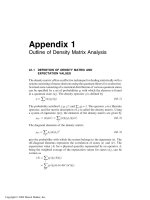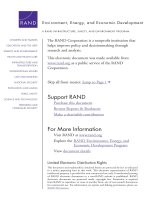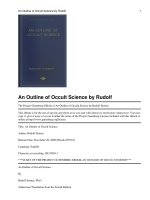Appendix 1 - Outline of Density Matrix Analysis
Bạn đang xem bản rút gọn của tài liệu. Xem và tải ngay bản đầy đủ của tài liệu tại đây (370.94 KB, 3 trang )
Appendix 1
Outline of Density Matrix Analysis
A1.1 DEFINITION OF DENSITY MATRIX AND
EXPECTATION VALUES
The density matrix offers an effective technique for dealing statistically with a
system consisting of many electrons using the quantum theory for an electron.
A mixed state consisting of a statistical distribution of various quantum states
can be specified by a set of probabilities p
j
with which the electron is found
in a quantum state j
j
i. The density operator is defined by
¼
X
j
j
j
ip
j
h
j
jðA1:1Þ
The probability satisfies 0 p
j
1 and
P
j
p
j
¼ 1. The operator is a Hermite
operator, and the matrix description of is called the density matrix. Using
a system of eigenstate fjnig, the elements of the density matrix are given by
nn
0
¼hnjjn
0
i¼
X
j
hnj
j
ip
j
h
j
jn
0
iðA1:2Þ
The diagonal elements of the density matrix
nn
¼
X
j
p
j
jhnj
j
ij
2
ðA1:3Þ
give the probability with which the system belongs to the eigenstate jni. The
off-diagonal elements represents the correlation of states jni and jn
0
i. The
expectation value hAi for a physical quantity represented by an operator A,
being the weighted average of the expectation values for states j
j
i, can be
written as
hAi¼
X
j
p
j
h
j
jAj
j
i
¼
X
jnn
0
p
j
h
j
jnihnjAjn
0
ihn
0
j
j
i
Copyright © 2004 Marcel Dekker, Inc.
¼
X
nn
0
n
0
n
A
nn
0
¼ TrfAgðA1:4Þ
Since hAi can be expressed by A and only, it is possible to calculate the
value of the macroscopic observable hAi without knowing j
j
i and p
j
,
provided that is obtained.
A1.2 EQUATION OF MOTION FOR THE DENSITY
OPERATOR
The time variation of a state j
j
i can be written by using the system
Hamiltonian H as
j
j
ðtÞi ¼ UðtÞj
j
ð0Þi, UðtÞ¼exp
ÀiHt
hh
ðA1:5Þ
and, if the time dependence of p
j
is omitted, the time variation of can be
written as
ðtÞ¼
X
j
UðtÞj
j
ð0Þip
j
h
j
ð0ÞjUðtÞ
y
¼ UðtÞð0ÞUðtÞ
y
ðA1:6Þ
Then, calculation of the time derivative of results in
d
dt
ðtÞ¼
HðtÞðtÞÀðtÞHðtÞ
ihh
¼
1
ihh
½HðtÞ, ðtÞ
ðA1:7Þ
Thus, the equation of motion for is described by using the commutation
relation between H and . When the initial state (0) is given by a matrix
representation based on an appropriate eigenstate system, solving the above
equation to calculate (t), followed by calculation of hAi by Eq. (A1.4),
clarifies the behavior of the whole system concerning the observation of the
quantity A. The above description is made in the Schro
¨
dinger picture using a
time-dependent operator (t). However, for cases where the Hamiltonian H
can be written as a sum of a Hamiltonian H
0
with the interaction omitted
and an interaction Hamiltonian H
i
, i.e.,
HðtÞ¼H
0
þ H
i
ðtÞðA1:8Þ
converting (t) into a density operator in the interaction picture:
I
ðtÞ¼U
0
ðtÞ
y
ðtÞU
0
ðtÞ, U
0
ðtÞ¼exp
ÀiH
0
t
hh
ðA1:9Þ
286 Appendix 1
Copyright © 2004 Marcel Dekker, Inc.
transforms the equation of motion into that in the interaction picture:
d=dt
I
ðtÞ¼
1
ihh
½H
I
ðtÞ,
I
ðtÞ ðA1:10aÞ
H
I
ðtÞ¼U
0
ðtÞ
y
H
I
ðtÞU
0
ðtÞðA1:10bÞ
where H
I
(t) is the interaction Hamiltonian in the interaction picture. Let
E
n
¼ hh!
n
be the energy eigenvalues of jni; then the density matrix elements
Inn
0
and
nn
0
are correlated by
nn
0
ðtÞ¼expðÀi!
nn
0
tÞ
Inn
0
ðtÞ, !
nn
0
¼ !
n
À !
n
0
ðA1:11Þ
In the interaction picture, the expectation value of A is given by
hAi¼Tr
I
ðtÞA
I
ðtÞ
ÈÉ
, A
I
ðtÞ¼U
0
ðtÞ
y
AU
0
ðtÞðA1:12Þ
Outline of Density Matrix Analysis 287
Copyright © 2004 Marcel Dekker, Inc.









